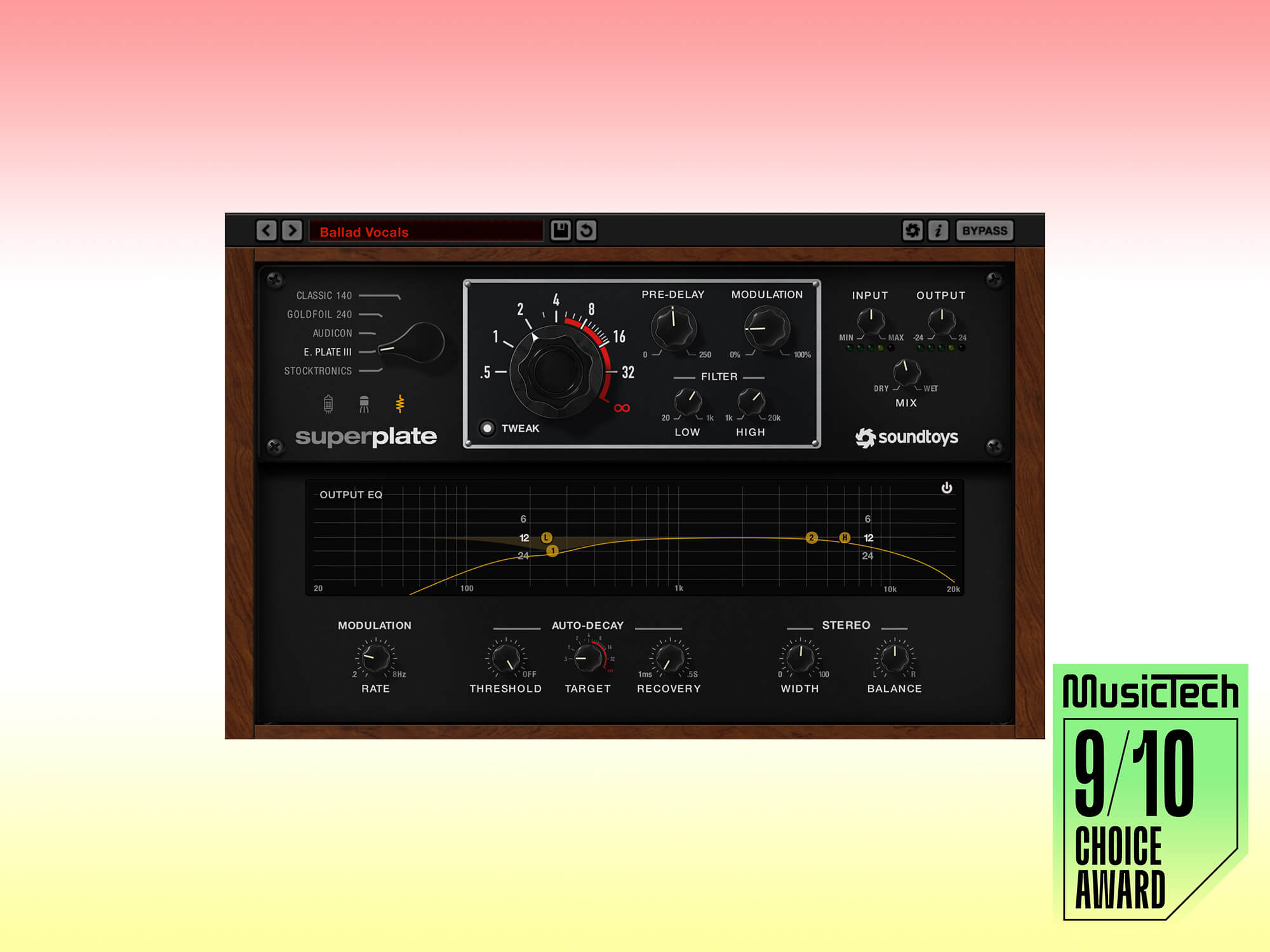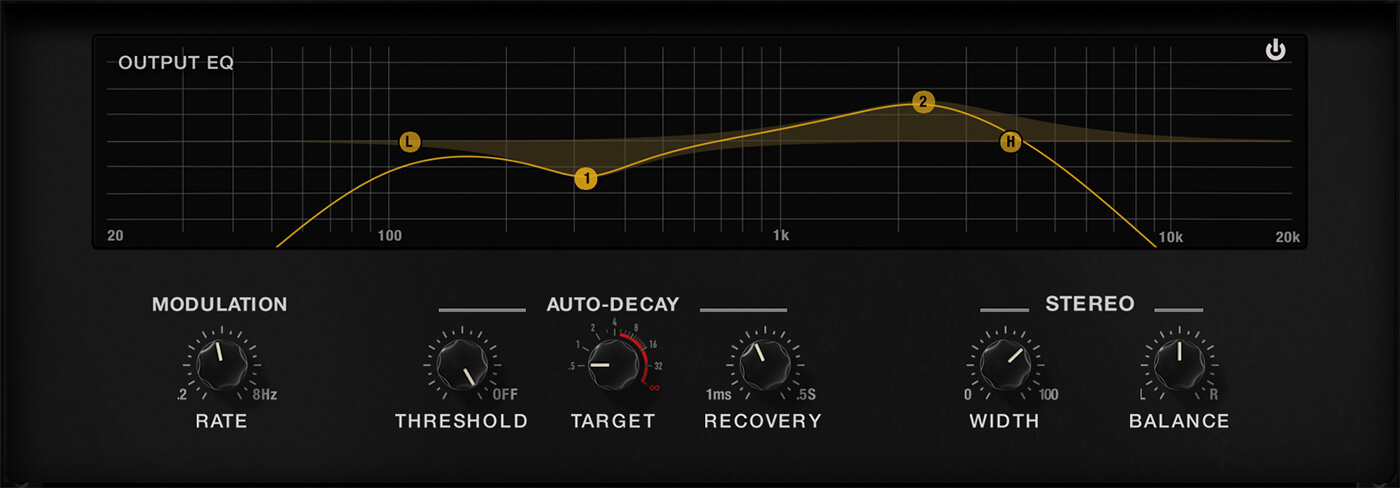Soundtoys SuperPlate was worth the wait
After a hiatus, Soundtoys returns with a fully-featured plate reverb. Is this the one to rule them all?

Soundtoys SuperPlate. Image: Soundtoys
Review Overview
Our rating
9
Our verdict
⊕ Sonically versatile (for a plate reverb)
⊕ Auto decay feature is effective at adding clarity to the dry signal
⊕ Quick to dial in sounds
⊖ Volume matching preamp modes are fiddly
⊖ Mix dial a little confusing at first
⊖ GUI not resizable
For over 15 years, Soundtoys’ plugin bundle has been considered by many producers as an essential tool for creative and characterful processing. Little Plate, Soundtoys basic plate reverb, was added to the collection five long years ago, leaving users twiddling their thumbs for the release of a full-featured version. Thankfully, it was worth the wait. Soundtoys SuperPlate has a wonderful sound, concise and easy to use GUI, and a few neat tricks up its sleeves.
LittlePlate had just one reverb plate emulation and limited controls; SuperPlate gives you the option of five different plate reverb units.
These are based on the classic EMT140 (full-bodied), a Goldfoil EMT240 (darker and tighter), an Audicon (for punch and sparkle), an EcoPlate III (bright and spacious), and a Stocktronics RX 4000 (with pronounced high-frequency response).
Soundtoys really went the whole hog in the design phase, studying the unique characteristics of multiple hardware models (including five EMT 140 units), before combining them to form single algorithms.
It’s great to have multiple options in a single plugin, as each has distinctive characteristics, so you can try them all to see which works best on your audio. You also have decay times beyond the original units’ capabilities, going all the way to infinity to create epic ambiences and pads. With that in mind, it’s a shame that the shortest decay is only 0.5 seconds, meaning you can’t create super-short, room ambience sounds.
Note that SuperPlate’s decay time has an effect on the way the different frequencies die away. Much like on the hardware it emulates, faster times are tighter and brighter, and longer times have a warmer, more boomy sound.
If you have the full SoundToys V5 bundle, then you can add SuperPlate by upgrading to V5.4 for a modest upgrade cost. This also gives you several new EffectRack presets that combine the reverb with other SoundToys processors to great effect.
Alongside the plate choices, you have three preamp options for colouring the signal going into the reverb, which include a clean setting, a harmonically-rich tube preamp, and a solid-state transistor overdrive that has built-in compression to help tame transients.

When testing on an emotive piano part, we find it especially effective at thickening the reverb and pushing the wet signal further back in the mix, and also for introducing pleasing, lo-fi warmth to the body and tail of the reverb. Frustratingly, it’s a chore to dial in the desired sound and then switch between the three drive settings.
You use the input dial to drive into the saturation, and then the output dial to rebalance the reverb signal volume. However, if you turn up the input to drive the Tube or Solid-State, and then switch to the Clean, you get a sizable volume jump. It would have been smoother for Soundtoys to implement a volume-matched amount dial for the coloured preamps, which wouldn’t affect the clean setting.
Elsewhere on the main GUI window are dials for decay, pre-delay, modulation amount, low cut and high cut, the aforementioned input and output, and a mix dial. It’s worth checking the manual here, as the mix dial doesn’t work exactly as you might expect. As you increase from 0 per cent to around 70 per cent, the dry remains unaffected and you are simply adding in more of the reverb signal; then from 70 to 100 per cent, you’re turning down the dry until it’s just the full, wet reverb sound. A little info on the GUI might have helped to avoid any confusion here for new users but, then again, maybe we should all just be reading our software manuals properly!
Although the GUI is fairly legible, it’s unfortunately not resizable, which is a common complaint aimed at Soundtoys’ plugins – as Marlon on the White Noise Studio YouTube channel says, after five years of receiving user feedback, Soundtoys shouldn’t have forgotten about this highly-requested feature.

Of course, it wouldn’t be a true Soundtoys plugin without the ubiquitous Tweak button, which opens up the other half of the GUI with additional editing options. The main thing you’ll notice is the EQ display that shows the low-cut and high-cut filters, plus two parametric bands. The filters are linked to the two dials above on the main GUI, but here you get the additional option to switch between 6db, 12dB and 24dB slopes.
It’s especially useful to have the two adjustable parametric bands, which we’re able to use to effectively clean up some unwanted frequencies before a guitar hits the reverb, and also to make adjustments to rebalance some of the colour added by the different plate models. There’s also a handy bypass button that only bypasses the bands and not the cut filters.
Below the EQ window are controls for the modulation rate, stereo width and stereo balance. Increasing the pitch modulation on the tail can add a more dreamy quality to things like keys or pads, with slow times providing a lo-fi, tape-esque vibe, and faster times a more vibrato-like shimmer.
We’re also able to reduce piano resonances building up on longer decay times, and push the reverb sound even further back in the mix. A Width dial keeps the reverb signal in full stereo at 100 or collapses down to mono at 0. This can be used in conjunction with the Balance dial to shrink sounds down and pinpoint them more specifically in the stereo field, while retaining the reverberated character.
Our favourite feature is the Auto-Decay function. This works similarly to using sidechain to duck the reverb when the clean signal is playing, but instead of volume, it reduces the decay time. Threshold sets the level the effect kicks in, and then a Target dial controls the amount of reduction, followed by a Recovery dial to set the release time. It’s a genius idea that we found works incredibly well to help clean up transient passages on guitar, piano and vocal parts. You get to keep the overall volume and character of the reverb, but without it washing out the entire signal when more prominent parts of the dry audio are playing. Joshua Casper from Plugin Boutique rightly calls it a “must-have” once you’ve used the feature for the first time.
Aside from a few minor misgivings, SuperPlate is a fantastic and versatile plate reverb plugin. It combines high-quality algorithms, a characterful hardware-style plate sound, and warm preamp modelling, with useful digital controls that can help you quickly sculpt the perfect reverb for your mix.
It might not be the plugin you turn to for more creative reverb sound design, but for pure plate tones, it’s one of the best we’ve heard.
Key Features
- Plate reverb plugin (VST2, VST3, AU, AAX Native, AAX Audiosuite)
- 5 plate styles
- EMT140, Goldfoil EMT240, Audicon, EcoPlate III & Stocktronics RX40000
- 3 preamp options: clean, tube and transistor
- Infinite decay
- Built-in pre-delay
- Modulation controls
- Decay ducking feature
- EQ with low cut and high cut filters and 2 parametric bands
- Price: $149 (SuperPlate only), $499 (Soundtoys 5 bundle), $59 (upgrade from Soundtoys V5 to V5.4 including SuperPlate)
- Contact: Soundtoys